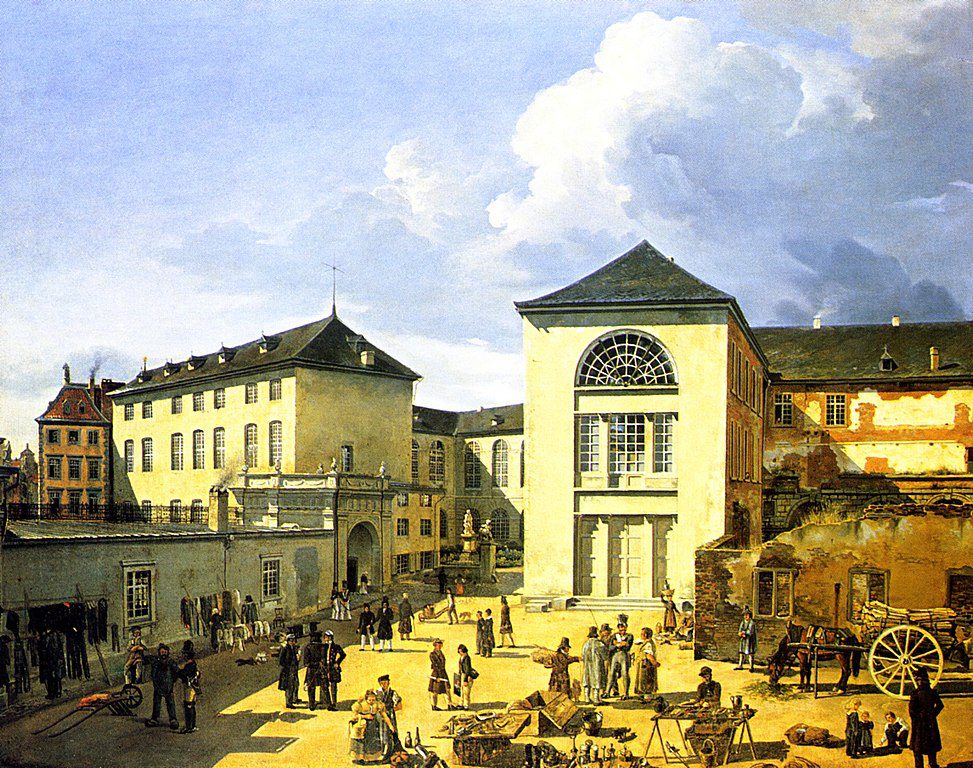
The Kunstakademie Düsseldorf is one of the most celebrated art academies in the world, steeped in history and known for shaping the course of artistic expression for over two centuries. From its modest beginnings in 1773 to its current status as a global hub of artistic innovation, the academy has been a cornerstone of cultural advancement. Its journey is not just a story of an institution, but a narrative of how art reflects and transforms societies. In this article, we’ll explore the origins, influential figures, artistic movements, resilience through turmoil, modern developments, and the future of this illustrious institution.
The Origins of Kunstakademie Düsseldorf: A Humble Beginning
Founded in 1773 by the visionary artist and art collector Lambert Krahe, the Kunstakademie Düsseldorf began with a mission to provide formal art education to the local community. Krahe, who served as the academy’s first director, aimed to instill a deep respect for classical traditions while nurturing technical proficiency among students. The academy was established under the auspices of the Electorate of the Palatinate, a region within the Holy Roman Empire that sought to promote culture and education as tools of civic pride. Düsseldorf, situated on the Rhine River, became an ideal location for fostering this burgeoning center of creativity.
The political and cultural climate of the time played a pivotal role in shaping the academy’s early goals. The late 18th century was marked by a renewed interest in classical antiquity, fueled by the Enlightenment and archaeological discoveries. The academy’s curriculum was initially focused on replicating the grandeur of classical art, with an emphasis on anatomy, proportion, and composition. Krahe’s personal collection of classical sculptures and drawings served as invaluable teaching materials for the students, solidifying the academy’s foundation as a classical art institution.
Despite its promising start, the academy’s growth was hindered by the socio-political upheavals of the era. The Napoleonic Wars and subsequent shifts in European power disrupted its operations, but the institution managed to endure. By the early 19th century, the academy began to reestablish itself as a significant cultural force, attracting aspiring artists from across the region. This period of resilience set the stage for the academy’s transformation into an internationally recognized institution.
The academy’s commitment to nurturing talent was evident even in its infancy, as it quickly gained a reputation for excellence. Its emphasis on classical training created a strong foundation for the artists who studied there, many of whom would go on to shape the artistic movements of their time. These early efforts laid the groundwork for the academy’s long-lasting legacy, which continues to influence the art world to this day.
Key Figures Who Shaped the Academy
The Kunstakademie Düsseldorf owes much of its success to the remarkable individuals who shaped its vision and reputation. Among these was Wilhelm von Schadow, a German painter who served as the academy’s director from 1826 to 1859. Under Schadow’s leadership, the academy flourished, and he is credited with establishing the renowned Düsseldorf School of Painting. His emphasis on narrative art, emotional depth, and technical precision attracted students and teachers from across Europe, elevating the academy to new heights.
Peter von Cornelius, another influential figure, played a pivotal role in shaping the academy during its early years. Known for his monumental frescoes, Cornelius was a key proponent of the Romantic movement and helped integrate its ideals into the academy’s curriculum. His passion for storytelling through art inspired a generation of painters, leaving an indelible mark on the institution. Though he eventually moved to Munich, his influence on the Kunstakademie Düsseldorf was profound and long-lasting.
Other notable contributors include Andreas Achenbach, a landscape painter whose works epitomized the Romantic fascination with nature. As both a student and teacher at the academy, Achenbach exemplified the institution’s commitment to blending technical skill with personal expression. Emanuel Leutze, a German-American artist best known for his painting Washington Crossing the Delaware, also emerged from the academy’s halls, further cementing its international reputation.
These key figures were instrumental in transforming Kunstakademie Düsseldorf into a global center of artistic excellence. Their leadership and artistic achievements not only defined the academy’s direction but also inspired countless students to pursue their creative dreams. The academy’s ability to attract such talent speaks to its enduring appeal as a place where art and ambition converge.
The Düsseldorf School of Painting: A Global Artistic Movement
The Düsseldorf School of Painting is one of the most significant legacies of the Kunstakademie Düsseldorf, characterized by its detailed, narrative-driven works. Emerging in the early 19th century under the guidance of Wilhelm von Schadow, this movement placed a strong emphasis on storytelling through art. Artists associated with the school often depicted historical, biblical, and genre scenes, combining meticulous detail with emotional resonance. These works resonated deeply with audiences, both in Germany and abroad, making the movement one of the first globally recognized styles originating from the academy.
One of the defining traits of the Düsseldorf School was its focus on precision and technique. Painters like Johann Wilhelm Schirmer, who specialized in landscapes, and Karl Friedrich Lessing, known for his historical and allegorical works, exemplified the movement’s ideals. The academy’s rigorous training program ensured that students mastered the technical skills needed to create such intricate compositions. This foundation allowed them to infuse their works with depth and complexity, earning widespread acclaim.
The international reach of the Düsseldorf School cannot be overstated. Aspiring artists from the United States, Scandinavia, and Eastern Europe flocked to the academy to study under its renowned faculty. Emanuel Leutze, for example, brought the movement’s ideals to America, where his iconic painting Washington Crossing the Delaware became a symbol of national pride. This global exchange of ideas enriched the movement and helped solidify the academy’s reputation as a cultural powerhouse.
Collaboration was another hallmark of the Düsseldorf School, as artists often worked together on projects or shared techniques. The academy’s supportive environment fostered a sense of community among its students and teachers, allowing for the free flow of creative ideas. This collaborative spirit not only strengthened the movement but also ensured its enduring influence on the art world.
Surviving the 19th and 20th Centuries: Turbulence and Transformation
The Kunstakademie Düsseldorf faced numerous challenges during the 19th and 20th centuries, navigating periods of political and social upheaval with resilience. The Napoleonic Wars and the subsequent redrawing of Europe’s borders disrupted the academy’s operations, but it managed to persevere. By the mid-19th century, the academy had regained its prominence, only to face new challenges during Germany’s unification and the rise of industrialization. These shifts forced the institution to adapt its curriculum, incorporating modern techniques alongside traditional methods.
The early 20th century brought the rise of modernism, which posed a direct challenge to the academy’s classical foundations. Artists like Paul Klee, who taught at the academy during the interwar years, represented a new wave of experimental and abstract art. Klee’s presence signaled a shift in the academy’s approach, as it began to embrace contemporary movements while maintaining its commitment to excellence. This period of transition was crucial in ensuring the academy’s continued relevance in a rapidly changing art world.
World War II marked one of the darkest chapters in the academy’s history. The building was heavily damaged during the Allied bombings, and many of its collections and records were lost. However, the post-war years saw a remarkable effort to rebuild, both physically and culturally. The academy emerged from the ashes as a symbol of resilience, once again becoming a beacon of artistic innovation.
The ability of the Kunstakademie Düsseldorf to survive and thrive during these turbulent times speaks to its enduring legacy. Its adaptability and commitment to nurturing talent have allowed it to remain at the forefront of the art world, even in the face of adversity. This resilience has ensured that the academy continues to inspire artists and audiences alike.
Modern Era: Innovation Meets Tradition
In the decades following World War II, the Kunstakademie Düsseldorf redefined itself as a hub for contemporary and experimental art. One of the most influential figures of this era was Joseph Beuys, who joined the academy as a professor in 1961. Beuys revolutionized art education with his radical ideas about conceptual art, performance, and the role of the artist in society. His famous dictum, “Everyone is an artist,” encapsulated his belief in the democratization of creativity, and his teachings left a profound impact on the academy.
The academy also became known for its photography program, led by Bernd and Hilla Becher. Their methodical, almost scientific approach to industrial photography laid the groundwork for a new generation of artists, including Andreas Gursky and Thomas Struth. This period marked a departure from the academy’s classical roots, as it embraced new media and forms of expression. The combination of tradition and innovation attracted students from around the world, further cementing the academy’s global reputation.
Gerhard Richter, one of the most celebrated painters of the modern era, also studied at the Kunstakademie Düsseldorf. His work, which ranges from photorealistic portraits to abstract compositions, exemplifies the academy’s ability to nurture diverse artistic voices. Richter’s success, along with that of other alumni like Sigmar Polke and Katharina Fritsch, underscores the academy’s role in shaping contemporary art.
Today, the Kunstakademie Düsseldorf continues to honor its classical foundations while pushing the boundaries of artistic innovation. Its interdisciplinary approach encourages students to experiment with new techniques and media, ensuring that the academy remains at the cutting edge of the art world. This dynamic blend of tradition and modernity is what makes the institution truly unique.
The Global Influence of Kunstakademie Düsseldorf Today
The Kunstakademie Düsseldorf has solidified its status as a global leader in art education, influencing countless artists and movements around the world. Its curriculum, which emphasizes both technical skill and creative freedom, attracts students from all corners of the globe. The academy’s focus on interdisciplinary learning has also fostered collaborations with other institutions, further extending its reach. This global perspective has allowed the academy to remain relevant in an increasingly interconnected art world.
Exhibitions featuring works by faculty and alumni have brought international recognition to the academy. From Andreas Gursky’s large-scale photographic prints to Gerhard Richter’s thought-provoking paintings, these artists showcase the diverse talents nurtured within the academy’s walls. The institution’s commitment to fostering creativity has not only benefited its students but also enriched the global art scene.
The academy’s influence extends beyond its alumni, as its faculty members continue to shape contemporary art through their own practices. By participating in global exhibitions, publishing research, and collaborating with other artists, they ensure that the academy remains a vital force in the art world. This ongoing engagement with the broader cultural community reinforces the academy’s reputation as a center of excellence.
As the Kunstakademie Düsseldorf continues to evolve, its impact on the global art scene shows no signs of waning. Its ability to adapt to changing times while maintaining its core values ensures that it will remain a beacon of creativity for generations to come. The academy’s enduring influence is a testament to the power of art to transcend borders and inspire new ways of thinking.
Preserving a Legacy: What Lies Ahead for Kunstakademie Düsseldorf
As the Kunstakademie Düsseldorf looks to the future, it faces the challenge of balancing its historic legacy with the demands of a rapidly changing world. Current leadership has emphasized the importance of innovation, introducing programs that address contemporary issues such as digital art and sustainability. These initiatives aim to prepare students for the evolving art world while preserving the academy’s commitment to excellence. The academy’s ability to adapt will be crucial in maintaining its relevance in the years to come.
Diversity and inclusion have also become key priorities for the academy. Efforts to recruit students and faculty from underrepresented backgrounds reflect a broader commitment to fostering creativity in all its forms. This focus on inclusivity ensures that the academy remains a welcoming space for artists from around the world, enriching its community with a wide range of perspectives.
The integration of technology into the curriculum is another area of focus. From digital painting to virtual reality installations, the academy is embracing new tools and techniques that expand the possibilities of artistic expression. By staying at the forefront of technological advancements, the academy continues to inspire innovation among its students.
Looking ahead, the Kunstakademie Düsseldorf remains committed to its mission of nurturing talent and pushing the boundaries of artistic expression. Its enduring legacy is a testament to the vision and dedication of its founders, faculty, and students. As it enters a new chapter, the academy stands poised to lead the art world into an exciting and transformative future.
Key Takeaways
- The Kunstakademie Düsseldorf was founded in 1773 by Lambert Krahe and has become one of the world’s most prestigious art academies.
- Influential figures like Wilhelm von Schadow, Joseph Beuys, and Gerhard Richter have shaped its reputation and impact.
- The Düsseldorf School of Painting established the academy as a global hub for narrative-driven, detailed art.
- The academy has successfully adapted to challenges, from war to modernism, while maintaining its commitment to excellence.
- Today, the academy blends tradition with innovation, preparing artists to lead in a rapidly changing world.
FAQs
What is the Kunstakademie Düsseldorf known for?
The academy is renowned for its classical foundations, the Düsseldorf School of Painting, and its role in shaping modern and contemporary art.
Who are some famous alumni of the Kunstakademie Düsseldorf?
Notable alumni include Gerhard Richter, Andreas Gursky, Joseph Beuys, Sigmar Polke, and Emanuel Leutze.
What is the Düsseldorf School of Painting?
It is an artistic movement emphasizing detailed, narrative-driven works, established under the leadership of Wilhelm von Schadow in the 19th century.
How has the academy adapted to modern art trends?
The academy has embraced contemporary practices like conceptual art, photography, and digital media while maintaining its classical roots.
What is the future of the Kunstakademie Düsseldorf?
The academy is focused on innovation, diversity, and technological integration, ensuring its continued relevance in the global art world.




